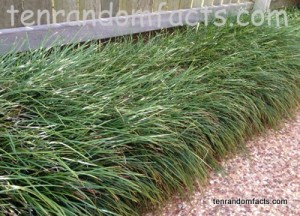
Swishy sway.
- Mondo grass is an evergreen, small grassy plant.
- Mondo grass is also known as fountain plant, monkey grass, dragon’s beard and snake’s beard and its official name is Ophiopogon japonicus.
- Mondo grass is native to Japan.
- Mondo grass plants range from 10 – 30 cm (4 – 12 inches) in height, depending on the variety.
- Mondo grass produce small white or pale lilac coloured flowers.
- Mondo grass produces a blue berry which is about 5 mm (0.2 inches) in diameter.
- Mondo grass is used in traditional Chinese medicine.
- Some people use Mondo grass as an aquatic plant, which normally dies if not kept in the right underwater temperature.
- Mondo grass blooms in late Spring and early Summer.
- Although some people think Mondo grass is a type of grass, it is actually a type of lily.















